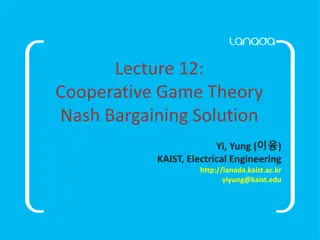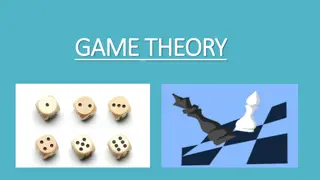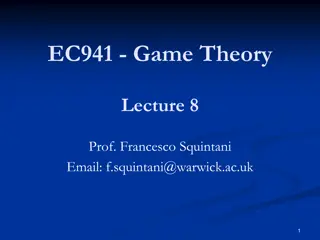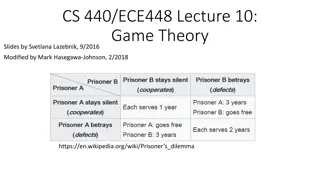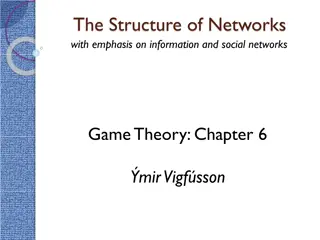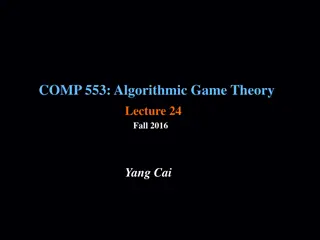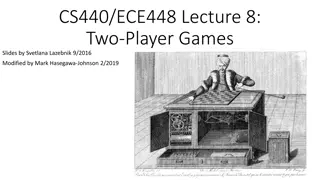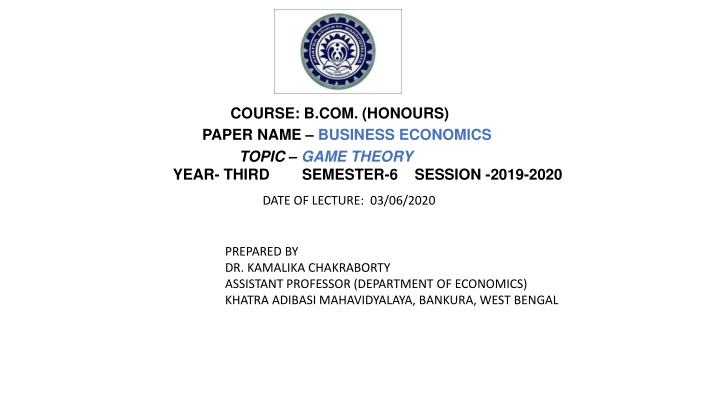
Game Theory: Important Concepts and Principles
Explore key terms in game theory like payoff matrix, saddle point, strategies, and more. Learn about two-person zero-sum games and the Maximin-Minimax Principle to analyze game outcomes effectively.
Download Presentation

Please find below an Image/Link to download the presentation.
The content on the website is provided AS IS for your information and personal use only. It may not be sold, licensed, or shared on other websites without obtaining consent from the author. If you encounter any issues during the download, it is possible that the publisher has removed the file from their server.
You are allowed to download the files provided on this website for personal or commercial use, subject to the condition that they are used lawfully. All files are the property of their respective owners.
The content on the website is provided AS IS for your information and personal use only. It may not be sold, licensed, or shared on other websites without obtaining consent from the author.
E N D
Presentation Transcript
COURSE: B.COM. (HONOURS) PAPER NAME BUSINESS ECONOMICS TOPIC GAME THEORY SEMESTER-6 SESSION -2019-2020 YEAR- THIRD DATE OF LECTURE: 03/06/2020 PREPARED BY DR. KAMALIKA CHAKRABORTY ASSISTANT PROFESSOR (DEPARTMENT OF ECONOMICS) KHATRA ADIBASI MAHAVIDYALAYA, BANKURA, WEST BENGAL
Importantterms related to Game Theory Payoff matrix: A matrix whose elements represent all the amounts won or lost by the row player. Payoff: An amount showing as an element in the payoff matrix, which indicates the amount gained or lost by the row player. Saddle point: The element in a payoff matrix that is the smallest in a particular row while, at the same time, the largest in its column. Not all matrices have saddle points. Strictly determined game: A game that has a saddle point. Strategy: A move or moves chosen by a player. Optimal strategy: The strategy that most benefits a player. Value (expected value) of game: The amount representing the result when the best possible strategy is played by each player. Zero-sum game: A game where what one player wins, the other loses; no money comes in from the outside or leaves.
Importantterms related to Game Theory (Contd.) Fair game: A game with a value of 0. Pure strategy: A player always chooses the same row or column. Mixed strategy: A player changes the choice of row or column with different plays or turns. Dominated strategy: A strategy that is never considered because another play is always better. For the row player, a row is dominated by another row if all the corresponding elements are all larger. For the column player, a column is dominated by another column if all the corresponding elements are all smaller. Two Persons Zero-sum Game. Two person zero-sum game is the situation which involves two persons or players and gains made by one person is equals to the loss incurred by the other. For example there are two companies Coca-cola & Pepsi and are struggling for a larger share in the market. Now any share of the market gained by the Coca-cola company must be the lost share of Pepsi, and therefore, the sums of the gains and losses equals zero. In other words if gain of Coca-cola is 40% so the lost share of the Pepsi will be 40%. The sum of game and losses is zero i.e. (+40%)+(-40%) = 0
THE MAXIMIN-MINIMAX PRINCIPLE (i) Maximin Criteria: The maximising player lists his minimum gains from each strategy and selects the strategy which gives the maximum out of these minimum gains. (ii) Minimax Criteria A : The minimising player lists his maximum loss from each strategy and selects the strategy which gives him the minimum loss out of these maximum losses. For Example Consider a two person zero sum game involving the set of pure strategy for Maximising player A say A1, A2 & A3 and for player B, B1 & B2, with the following payoff Player B B1 B2 Row Minima Player A A1 9 2 2 A2 8 6 6*Maximin A3 6 4 4 Column Maxima 9 6* Minimax Here Maximin payoff = Minimax payoff Value of the game = 6
Saddle Point The Saddle point in a pay off matrix is one which is the smallest value in its row and the largest value in its column. The saddle point is also known as equilibrium point in the theory of games. An element of a matrix that is simultaneously minimum of the row in which it occurs and the maximum of the column in which it occurs is a saddle point of the matrix game. In a game having a saddle point optimum strategy for a player X is always to play the row containing saddle point and for a player Y to play the column that contains saddle point. Player B B1 B2 Row Minima In this game the saddle point is (A2, B2) A1 9 2 2 Player A A2 8 6 6*Maximin A3 6 4 4 Column Maxima 9 6* Minimax







